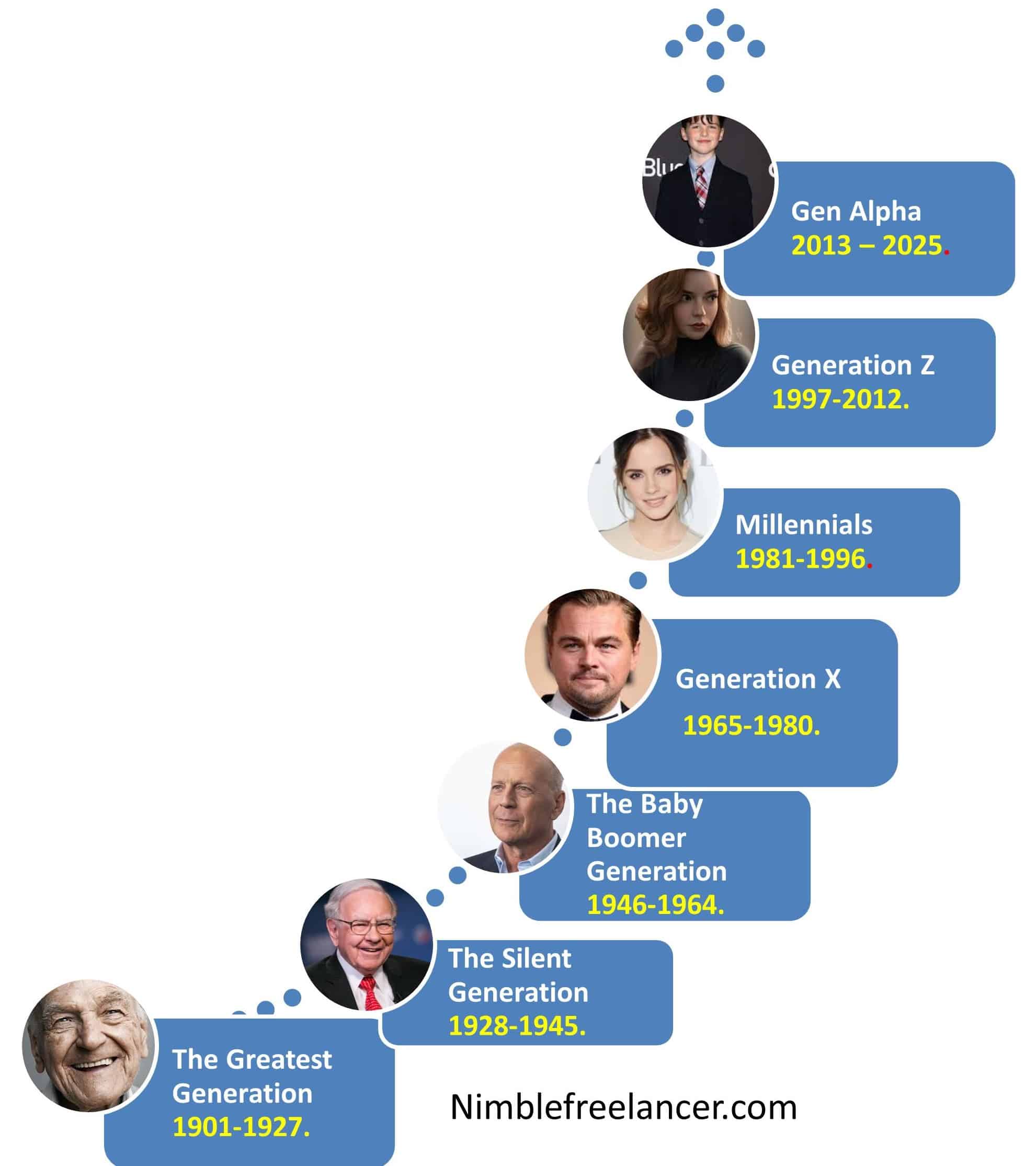Generation X, commonly abbreviated as Gen X, is the demographic cohort that follows the Baby Boomers and precedes the Millennials. Born between the mid-1960s and the early 1980s, specifically from 1965 to 1984, they experienced significant societal shifts during their formative years. Often dubbed the “MTV Generation,” they were the first to grow up with emerging technologies like personal computers. They faced changing family dynamics in their youth, characterized by rising divorce rates and increased maternal workforce participation. Culturally and politically, they navigated the challenges and changes of the late 20th century, from evolving music genres to the end of the Cold War.
Facts About Generation X
- Generation X follows the Baby Boomers and precedes the Millennials.
- They were born between the mid-1960s and early 1980s, specifically 1965 and 1984.
- As of 2019, there were approximately 65.2 million Gen Xers in the United States.
- Many Gen Xers are children of the Silent Generation and early boomers.
- They often parented members of the Millennial and Generation Z cohorts.
- Gen Xers grew up during shifting societal values, notably in the 1970s and 1980s.
- They were sometimes called the “latchkey generation” due to rising divorce rates and increased maternal participation in the workforce.
- In their youth, Gen Xers were dubbed the “MTV Generation.”
- Musical genres like punk, post-punk, heavy metal, grunge, and grindcore influenced Gen X.
- The film industry, with mega-sequels and independent films, was a significant cultural element for them.
- They were the first generation to experience video games as mainstream entertainment.
- Gen Xers in Eastern Bloc nations witnessed the transition from communism to capitalism during their youth.
- In the early 21st century, they are often described as achieving a balance between work and life.
- Gen Xers were the first to have access to personal computers at home and in schools.
- The rise of personal computing in the early 1980s saw companies like Commodore, Atari, and Apple introduce new machines.
- This generation witnessed the growth of storage solutions like floppy disks, zip drives, and CD-ROMs.
- In terms of civil rights, they grew up post-Jim Crow and were among the first to experience school busing for integration purposes.
- By the 1990s, they were described as the least racist of the generations.
- Many Gen X women benefited from Title IX, which provided increased athletic opportunities.
- A significant proportion of Gen Xers pursued higher education than the Baby Boomers.
- College enrollment for this generation saw significant growth from 1983 to 1998.
- Many Gen Xers faced mounting student debts due to rising educational costs.
- Gen X women outpaced men in terms of college completion rates.
- The late 1980s and early 1990s job market posed challenges for Gen X due to economic downturns.
- They witnessed transformations in traditional employer-employee relationships, with trends like corporate downsizing.
- Politically, they grew up in the shadows of events like the Vietnam War and the Watergate scandal.
Generation X was the first to grow up with personal computers in their homes and schools. During the early 1980s, there was a surge in the use of personal computers, with companies like Commodore, Atari, and Apple introducing 8-bit and 16-bit machines. This boom in hardware led to advancements in software, resulting in the proliferation of storage solutions like floppy disks, zip drives, and CD-ROMs. In education, the U.S. Department of Education initiated several computer projects under Terrel Bell’s “Technology Initiative.”. This initiative parallels the U.K.’s “Computers for Schools” program in 1982 and France’s 1985 “Plan Informatique pour Tous.”
In the context of civil rights in the U.S., Gen Xers grew up in the post-Jim Crow era and experienced the aftermath of the civil rights movement. They were part of the busing system to achieve racial integration in schools. By the 1990s, Gen X was seen as the least racist generation, having grown up in a period that saw significant strides towards equality. Title IX, introduced in 1972, enhanced athletic opportunities for Gen X girls. The series “Roots” also played a pivotal role in shaping their understanding of Afro-American history.
Higher education saw a surge with Generation X. Compared to the Baby Boomers, more Gen Xers attended college. Beginning in 1983, college enrollments increased, peaking in 1998. This surge also came with mounting student debts as education became costlier. Significantly, women in this generation surpassed men in college completion rates.
Entering the job market in the late 1980s and early 1990s was challenging for Gen X due to economic downturns, including the collapse of many savings and loan associations. Traditional employer-employee relationships transformed, marked by large-scale layoffs, corporate downsizing, and offshoring. Politically, this generation matured during the Reagan and Bush presidencies, having grown up in the aftermath of the Vietnam War and the Watergate scandal. Many became disillusioned with politics, especially after witnessing the fall of the Berlin Wall and the consequent belief that no viable alternative to capitalism existed.


